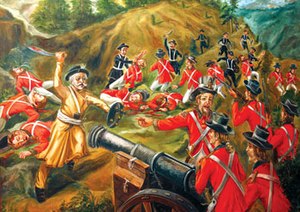Gurkha War
The Gurkha War (also known as the Anglo-Nepalese War ) was a military conflict between the Kingdom of Gorkha and the British East India Company between 1814 and 1816 .
Gorkha was a small principality in western Nepal and is the namesake of today's district . This principality expanded its area of influence and united around 50 principalities under Prithvi Narayan Shah to form the Kingdom of Gorkha (1768). By advancing south, the Gorkhali, as they called themselves, came under the control of the British East India Company, which was pushing north. The Gorkhali had an imprecisely defined border about 800 miles long with the British and Avadh , which gave rise to frequent disputes. Under Earl Minto , it was announced that the disputed territories would be occupied by force if necessary, and when Francis Hastings took over as governor-general, that threat was carried out. The British occupied the areas cleared by the Gorkhali.
course
With the onset of the rainy season , the British withdrew their troops, whereupon the Gorkhali reoccupied the areas and killed some police officers in the process. Hastings opted for military action, even if there were some dissenting votes because of the danger that Maratha posed and the cost.
When the weather permitted, Hastings put four columns in march, but they met with strong resistance. The 3,500 men under Major General Robert Gillespie lost 740 men in an attempt to take a small fort near Kalanga . Gillespie himself was killed in the first attack. A month later, the Gorkhali even managed to put the British and their sepoys to flight. Gillespie's column had now lost a third of its manpower, and further advance was given up. Two more columns also failed, and Major General John Wood decided in January 1815 not to let his 4,000 men advance.
Major General Marley was to advance to Kathmandu with 8,000 men in the east and also achieved an initial success, but then stopped his advance for December to await reinforcements. When two outposts set up some distance away were overrun by Gorkhali, Marley's sepoys began to flee. Marley, who now had between 12,000 and 13,000 men, withdrew to the border and stood idle for a month. He left his forces on February 10 and was relieved of his command as a result.
Only David Ochterlony had made progress in the Satluj area , and British morale was therefore bad.
Hastings increased the number of soldiers deployed to 40,000 at the beginning of 1815, compared to 12,000 Gorkhali. This was the bulk of the troops available and in the event of an attack by the Marathas, Sikhs or Pindari the British would have got into trouble. In the spring of 1815, Ochterlony made progress. He avoided attacking the Gorkhali forts directly, but built roads on which the artillery could be brought in. With this he succeeded in removing the barriers and forts and forcing the Gorkhali to attack. A new expedition under Colonel Jasper Nicolls managed to capture Almora and thus cut off the Gorkhali troops under Amar Singh from Nepal. Amar Singh's soldiers deserted in large numbers and he was forced to surrender.
Hastings replenished existing battalions from deserted Gorkhali, who the English referred to as Goorkhas or Gurkhas, which became part of the army of the British East India Company. In November a treaty was signed in which the Gorkhali renounced the disputed areas, ceded large areas of the Terai and all areas conquered west of the Kali to the British, and accepted a British resident in Kathmandu.
However, the Gorkhali Hof rejected the conditions, which is why the fighting resumed in the spring of 1816. Ochterlony advanced with 20,000 men on Kathmandu and fought back a Gorkhali force at the Chuviaghati Pass without a fight. A few days later, in March, he dismissed an attack by the Gorkhali, and the kingdom accepted the treaty.
Gorkha remained an independent kingdom and later took the name Nepal, which was once only used for the Kathmandu valley. The Gurkha battalions first established by Ochterlony are still part of the British and Indian armies today .
